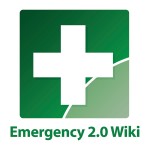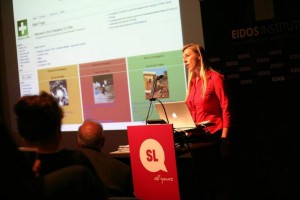I believe in the power of the crowd to change the world.
It’s how the Emergency 2.0 Wiki, a free global online resource and knowledge-sharing platform for helping communities use social media in disasters, came into being. This world first initiative would not have been possible without social media and an online global crowd of volunteers.
Leading the Emergency 2.0 Wiki as founder and CEO in a voluntary capacity, is the other hat that I wear, along with operating Byron Bay Social Media.
Now I am turning to the crowd to support my Pozible crowdfunding appeal to help me travel to Switzerland to present for the Emergency 2.0 Wiki at the 5th International Disaster and Risk Conference (#IDRC2014) 24-28 August in Davos.
 #IDRC2014 is organised by the Global Risk Forum in cooperation with the United Nations Office for Disaster Reduction (UNISDR) and is the largest world gathering of key players in this field.
#IDRC2014 is organised by the Global Risk Forum in cooperation with the United Nations Office for Disaster Reduction (UNISDR) and is the largest world gathering of key players in this field.
Importantly, it is also an opportunity to shape world policy. As a speaker I will be making recommendations for the Post 2015 Disaster Risk Framework to be ratified at the UN World Conference WCDRR in Sendai, Japan in 2015.
About the Emergency 2.0 Wiki
The Emergency 2.0 Wiki is a free online global resource and knowledge sharing hub for using social media and new technologies in emergencies.
The wiki serves a global hub for emergency response agencies, government, NGOs, schools, hospitals, community groups, faith based groups, business, media and citizens to use social media to better prepare for, respond to and recover from emergencies.
The wiki provides tips, guides, apps, mapping tools, videos and an international directory of emergency services on social media. It has tips for citizens to help themselves and help others, an accessibility toolkit for people with disabilities and guidelines for emergency services, government, community groups and NGOs, schools, hospitals and business.
The Emergency 2.0 Wiki facilitates collaboration, knowledge sharing and crowdsourcing across the industry sectors to provide users around the world with the latest information, best practices and resources. The Emergency 2.0 Wiki is a nonprofit run entirely by volunteers and is yet to officially begin fundraising (hence this crowd funding appeal) . The development of Wiki content is overseen by international volunteer reference groups of professionals with expertise in the field.
What we believe
We believe that together we can help create a world where communities use social media to save not only their own lives in a disaster, but also the lives of others. A world where:
- Emergency response agencies use social media to issue alerts and warnings to save lives
- Emergency response agencies engage with the community as partners
- The community is prepared, including people with a disability
- Digital volunteers from across the globe provide ‘information aid’ during and after disasters
- The community reaches out to help the community
The Emergency 2.0 Wiki believes that social media can play a transformative role in making disaster resilience a social norm. Social media offers the potential to help create a level of resilience that ensures communities don’t just ‘bounce back’ after a disaster, but ‘bounce forward’, becoming stronger with increased social networks, social cohesion and social capital. This requires a whole of community approach to using social media for disaster resilience in which the community becomes partners in disaster resilience.
In my presentation I will be showcasing how this can be done using best practice examples from around the world and sharing how the Emergency 2.0 Wiki can help.
The Catalyst for the Emergency 2.0 Wiki
The catalyst for creating wiki was the 2011 Queensland floods. Like many people, I saw the television coverage of the Toowoomba flash flood. I watched in horror as cars with people trapped in them were washed down the street, shortly before the inland tsunami swept through the Lockyer Valley, washing away houses with people clinging to roofs desperately awaiting rescue helicopters. There was tragic loss of life that day and I wondered how many lives could have been saved if people had received warnings earlier, via social media alerts to their mobile phones – not just from emergency services, but from people on the ground who witnessed the wall of water coming through. The use of social media for emergency communications was in its infancy then. We had the technology, but we didn’t have mass take-up. Today we still have a long way to go in Australia and internationally.
My personal driver
As a childhood survivor of Cyclone Tracy which destroyed Darwin in 1974, and in which I lost my home, family photos and pets, I am passionate about helping build community resilience and I believe social media is a most powerful enabler for this.
Rewards for supporting the Pozible appeal
Supporters have the option to receive a public thank you on social media through various channels:
- My channels as Emergency 2.0 Wiki Founder & CEO (Twitter, Google+)
- Byron Bay Social Media Facebook and my personal page
- Emergency 2.0 Wiki (Twitter, Google+)
Also on offer is a listing as a key supporter on my PowerPoint presentation at the Conference. The PowerPoint will be posted after the Conference on the Emergency 2.0 Wiki Library and Events Page as well as the IDRC website.
For businesses there is also the opportunity to receive a Tip Guide from my consultancy Byron Bay Social Media on how to use Twitter to build your brand profile and reach new customers. Also on offer are five customised tips on how your business could use social media to build your brand while doing good.
I encourage everyone to share your support of this appeal via your social networks to help us raise awareness and reach the fundraising target. If you are a business, supporting this cause online has the added bonus of potentially helping you build brand value, develop brand advocates, increase customer loyalty and attract new customers, as research has found that people prefer brands that support causes and they like to use social media to promote causes.
Challenges
We have a very short timeframe to raise the funds (the Pozible campaign deadline is Monday 18 August). Together we can do it, and I’m thanking you in advance for your support!
Sharing learnings
I plan to share learnings from this Pozible appeal in a future blog post to help those considering crowdfunding.
Many thanks for your support.
Cheers, Eileen
P.S. Together we can make our world safer
Image credits
- Social Media in Times of Crisis National Symposium: Eidos Institute Facebook. Photographer Fiona Muirhead, facebook.com/fionamuirheadphotography
- Queensland floods: via Flicker Kingbob.net http://www.flickr.com/photos/kingbob86/5342341008/sizes/l/in/photostreamFlickr
- Cyclone Tracey: Photographer unknown, image via ABC http://www.abc.net.au/aplacetothink/html/cyclone.htm
Related articles:
- Wiki to present at global disaster forum (emergency20wiki.org)
- Eileen Culleton – Founder of the Emergency 2.0 Wiki, Ideas Hoist – Australians Making Ideas Happen (ideashoist.com.au)
- Harnessing the transformative power of social media for social good (byronbaysocialmedia.net.au)
- Digital Persuasion: Social Media Motivates People to Contribute Beyond Clicks (csic.georgetown.edu/news)
- Charity makes consumers switch brands (cavil.com.au)






Pingback: Presenting at global disaster forum #IDRC2014 | Byron Bay Social Media